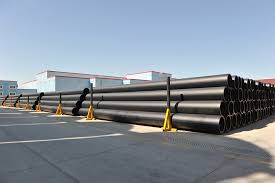Oct . 12, 2024 12:01 Back to list
hdpe pipe for water supply specifications factory
Specifications and Quality Standards for HDPE Pipe in Water Supply Systems
High-Density Polyethylene (HDPE) pipes have become an essential component in modern water supply systems due to their excellent durability, flexibility, and resistance to corrosion. When it comes to specifications for HDPE pipes used in water supply, it is crucial to adhere to standard guidelines to ensure safety, efficiency, and long-term service. This article provides an overview of the specifications and quality standards for HDPE pipes specifically designed for water supply applications.
Material Composition
HDPE pipes are made from polyethylene resin, which gives them their high strength-to-density ratio. The most common grade used for water supply applications is PE 100, which offers better mechanical properties and a higher resistance to stress cracking than its predecessor, PE 80. The material must be compliant with the standards set by organizations such as ASTM International and the American Water Works Association (AWWA).
Manufacturing Standards
The manufacturing process of HDPE pipes involves extrusion, where molten material is forced through a die to form the pipe shape. According to ASTM D3035 and AWWA C901/C906, the pipe must meet specific requirements for wall thickness, diameter, and tolerance to ensure proper functionality and performance. The pipes are usually available in diameters ranging from 0.5 inches to more than 63 inches, accommodating various pipeline needs.
Mechanical Properties
HDPE pipes are known for their high tensile strength, impact resistance, and excellent flexibility. The pipe should exhibit a minimum allowable head pressure rating (often referred to as pressure class) to ensure it can withstand the operation conditions. The commonly used pressure ratings include 160 psi, 200 psi, and 315 psi, depending on the intended application. Additionally, the pipes should maintain their structural integrity over a range of temperatures, commonly between -20°C and 60°C (-4°F to 140°F).
hdpe pipe for water supply specifications factory

Environmental Resistance
One of the advantages of HDPE pipes is their resistance to the effects of UV radiation and environmental stresses. However, the specifications typically outline that HDPE pipes should be tested for resistance against various chemicals that they might encounter in the environment. Standards such as ISO 4427 specify the long-term hydrostatic strength (MRS) for HDPE, ensuring that the pipe can function effectively in harsh environments.
Certification and Compliance
For HDPE pipes used in potable water supply systems, compliance with health and safety regulations is paramount. Pipes should be certified by relevant authorities such as NSF International or the Water Quality Association to ensure they meet safety standards for drinking water. These certifications are critical proof that the materials used do not leach harmful substances into the water supply.
Installation Guidelines
Correct installation practices are critical in ensuring the longevity and functionality of HDPE pipes in water supply applications. Specifications often outline the method for joining pipes, such as butt fusion or electrofusion, as well as guidelines for trenching, backfilling, and preventing pipeline movement. It is crucial to follow these guidelines closely to avoid future leaks or pipeline failures.
Conclusion
In conclusion, HDPE pipes offer a reliable, cost-effective solution for water supply systems when manufactured and installed according to established specifications. Standards governing the material composition, mechanical properties, environmental resistance, and compliance certification ensure that these pipes can effectively meet the demands of modern infrastructure. For engineers and contractors involved in water supply projects, understanding these specifications is vital for ensuring the safety and efficiency of water distribution systems. By adhering to these guidelines, stakeholders can make informed decisions that lead to better project outcomes and enhanced public safety.
-
High-Quality PVC Borehole Pipes Durable & Versatile Pipe Solutions
NewsJul.08,2025
-
High-Quality PVC Perforated Pipes for Efficient Drainage Leading Manufacturers & Factories
NewsJul.08,2025
-
High-Quality PVC Borehole Pipes Durable Pipe Solutions by Leading Manufacturer
NewsJul.08,2025
-
High-Quality PVC Borehole Pipes Reliable PVC Pipe Manufacturer Solutions
NewsJul.07,2025
-
High-Quality UPVC Drain Pipes Durable HDPE & Drain Pipe Solutions
NewsJul.07,2025
-
High-Quality Conduit Pipes & HDPE Conduit Fittings Manufacturer Reliable Factory Supply
NewsJul.06,2025

